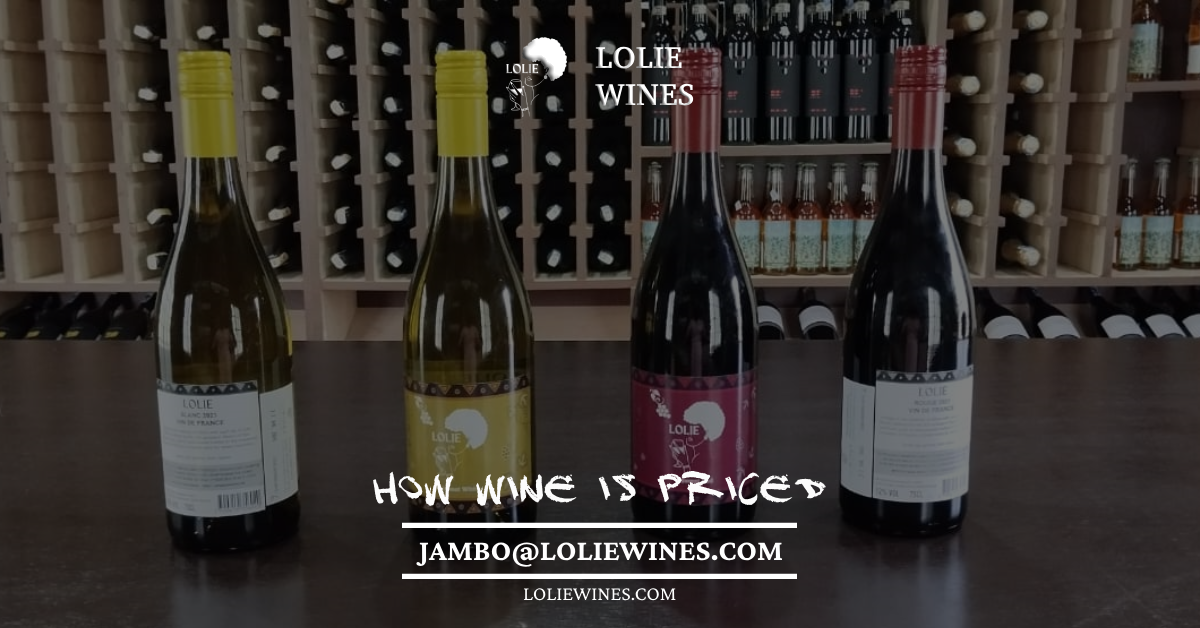Wine pricing can be a complex topic, influenced by various factors ranging from production costs to brand prestige. Knowing what makes a wine expensive and what a wine’s name can tell you about its quality helps consumers make more informed choices. In this article, we explore how wine is priced, how to determine if a wine is expensive, and what the wine name indicates. We also provide a general pricing overview for wines, both wholesale and retail, featuring brands available at Galina Africa.
How is Wine Priced?
The price of a wine is determined by several key factors, each contributing to the overall cost:
1. Production Costs
The cost of producing wine is one of the most significant factors in determining its price. This includes the cost of grapes, labor, winemaking processes, aging, and packaging. High-quality grapes from renowned regions or specific vineyards can be more expensive, as can the costs associated with meticulous winemaking techniques.
2. Aging Process
Wines that require longer aging times tend to be more expensive. This is because aging requires storage space, barrels, and time, all of which add to the production cost. For example, some wines from the De Wetshof Estate undergo extended aging, resulting in a richer flavor and a higher price tag.
3. Region and Terroir
The region where the wine is produced also significantly impacts its price. Wines from prestigious regions such as Bordeaux, Burgundy, or Napa Valley are generally more expensive due to the region’s reputation for high-quality wines. The unique terroir of these regions contributes to the wine’s distinct flavors and quality, justifying a higher price.
4. Brand and Prestige
Brand reputation plays a crucial role in wine pricing. Wines from well-known producers like Marques De la Concordia or Bushmanspad Wines often command higher prices due to their established reputations for quality and consistency. A brand’s prestige can add a premium to the wine’s cost, especially if it has won awards or received high ratings from critics.
5. Limited Production
Wines produced in limited quantities are often more expensive. This scarcity can drive up demand, allowing producers to charge more. Limited-edition wines or those from smaller, boutique wineries often fall into this category.
How to Know If a Wine is Expensive
Identifying whether a wine is expensive involves understanding several aspects of its production and labeling:
1. Check the Region
Wines from renowned regions or appellations tend to be pricier. Look for names like Bordeaux, Napa Valley, or Champagne. These regions are known for producing high-quality wines, often at higher prices.
2. Consider the Grape Variety
Some grape varieties are more expensive to grow and produce than others. For example, Pinot Noir, which requires careful handling and specific growing conditions, often results in a higher-priced wine compared to more common varieties like Merlot.
3. Look for Vintage Information
Older vintage wines are typically more expensive, especially if the vintage is from a particularly good year. Wines from well-rated vintages have higher prices due to their perceived quality and aging potential.
4. Understand the Label
A wine’s label can tell you a lot about its quality. Terms like “Reserve,” “Estate Bottled,” or “Grand Cru” usually indicate a higher quality wine. Additionally, wines with labels indicating a specific vineyard or winemaker often come with a higher price tag.
What the Wine Name Says About Quality
A wine’s name can provide insight into its quality and origins:
1. Vineyard or Estate Name
Wines that include the name of a specific vineyard or estate, such as De Wetshof Estate, are typically of higher quality. These wines are often made from grapes grown in a single location, allowing for greater control over quality and consistency.
2. Wine Style or Production Method
Some wine names include information about the production style or method. Terms like “Barrel Fermented” or “Late Harvest” indicate specific winemaking techniques that can affect the wine’s flavor and price.
3. Geographic Indications
Geographic indications on wine labels, such as “DOCG” (Denominazione di Origine Controllata e Garantita) in Italy or “AOC” (Appellation d’Origine Contrôlée) in France, denote strict quality controls and can be an indicator of higher-priced wines.
General Pricing of Wines: Wholesale vs. Retail
Wines are available at different price points depending on whether they are purchased wholesale or retail:
Retail Pricing
- Lolie Red
- Lolie White
- Vinum Wine
- Marques De la Concordia
- De Wetshof Estate
Wholesale Pricing
Wholesale prices can vary significantly depending on the quantity purchased and the distributor. Wholesale wine prices are generally 20-40% lower than retail prices, offering a significant discount for bulk purchases. At Galina Africa, you can find wholesale pricing for various premium brands such as:
- Bushmanspad Wines
- De Wetshof Wines
- Deuric Wines
- Marques De la Concordia
- Peninsula Wines
- The Vinum Wines
- Thr3 Monkeys Wines
- Water Wines
For those interested in purchasing wines wholesale, Galina Africa offers a wide range of options from these brands, providing an excellent opportunity to buy in bulk at reduced prices.
Conclusion
Understanding how wine is priced and what factors contribute to its cost can help you make more informed decisions when selecting a bottle. By considering elements like production costs, region, grape variety, and brand reputation, you can better understand why some wines are more expensive than others. For those looking to purchase in bulk, Galina Africa provides a wide range of wines at competitive wholesale prices, making it an excellent choice for businesses or wine enthusiasts looking to stock up.
Email – [email protected]
